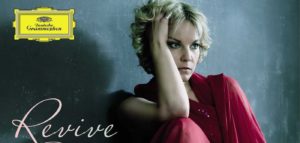Elina Garanca has steadily been moving to the dramatic mezzo-soprano repertoire as her career has developed. In this new solo album, the mezzo-soprano showcases what audiences will hopefully see in the future.
“Revive,” the title Garanca has chosen for her album, is a mix of many popular tunes from the mezzo repertoire and some rarely heard. The result is an interesting album that shows off Garanca’s vocal power and range as well as her dramatic sensibility but could turn off some listeners who are looking for pure melodies.
The hits
Garanca chooses to begin her album with some of the most popular tunes including Mascagni’s “Voi Lo Sapete” from “Cavalleria Rusticana.” The aria, which inspired the album, is sung with committed abandon. Garanca clearly has a sense of the character and the suffering of Santuzza is perfectly displayed, particularly in the lower register.
The second aria in the CD from Cilea’s “Adriana Lecoureur” is also sung with a plush voice bringing out some Garanca’s nuanced phrasing. She starts with the very dramatic “Acerba Volutta” and swiftly shifts to the more lyrical second section with a lush sound caressing each phrase.
Garanca also showcases her vocal fireworks in the aria “Nel Giardin del Velo” from Verdi’s “Don Carlo.” If anyone doubted that Garanca has the virtuosic power for this aria, here she sings the difficult coloratura lines with ease and there is a playfulness to her interpretation. Each high note is sung without any hesitance. It’s a shame that “O Don Fatale” is not on this album as it would have been a great contrast to see how Garanca handles the two extremes of this upcoming role.
However, she does include “Rataplan” from Verdi’s “La Forza del Destino.” There is so much power in her interpretation giving way to a real battle cry. And it is delightful to listen to her clear diction as she revels in each word during this a cappella chorus.
Garanca includes two very popular French arias and one that isn’t as popular. The first comes from Berlioz’s “Les Troyens.” In the aria “Ah! Ah! Je vais mourir … Adieu, fière,” Garanca once again combines her lyrical side with her dramatic side and brings out a heartbroken women in the aria.
In the “Va! Laisse couler mes larmes” from Massenet’s “Werther,” she sings the aria as a lament and it is brilliantly accompanied by the saxophone.
Meanwhile her aria from Saint-Saens’ “Samson et Dalila “Samson, recherchant ma présence” uses her lush voice to create an impeccable seductress who has some doubts about the actions she is about to commit.
The surprises
The second part of the album is filled with rare arias and some surprises. The one aria that is effective and convincing is the opening soprano aria “Io Son L’Umile ancelle” from “Adriana Lecouvreur.” Not only does Garanca’s voice support the higher register in the aria but she is able to fluctuate each dynamic with ease. The final B Flat is sustained with a powerful crescendo, showing Garanca’s gleaming upper register and the power of her voice.
The aria is a great contrast from the mezzo aria “Acerba Volutta” as “Io Son L’Umile Ancella” demonstrates light qualities to the voice.
This aria could also be a sign that Garanca has some plans to move into the soprano territory. The mezzo has showed interest in “Tosca” and “Macbeth” and perhaps this is just a test into these heavier works.
The aria from Ponchielli’s “La Gioconda,” “Ho il cuor gonfio di lagrime … Stella del marinar!” also shows Garanca’s spirit in expressing a range of emotions. The aria is short but effective and in the faster sections Garanca performs it at quick speed characterizing Laura with some impatience toward seeing her lover. But it is Garanca’s expressive rapport in the more lyrical lines that really show the impassioned character. It is one of the standout tracks in the album and an aria that really suits the mezzo’s temperament.
The one Russian selection in this album comes from Mussorgsky’s “Boris Godunov.” In “Skučno, Marine,” Garanca perfectly displays her understanding of the Russian composers complex rhythms and gives the aria a very seductive flare amidst the rhythmic lines.
The album also includes arias from Massenet’s “Herodiade,” Saint Saens “Henry VIII” and Thomas’s ‘Mignon.
Orchestra and conclusion
Roberto Abbado joins Garanca in this CD and it is unique to hear the difference in color of the French and Italian works. Abaddo makes these distinctions present with his approach. The Italian pieces are performed with more weight and more direct movement. Meanwhile, the French pieces get a lighter touch and this sometimes makes for a more introspective listening experience.
This writer does have one complaint however. The album feels a bit front loaded with the popular tunes and by the middle and end of the CD, the majority is filled with unknown pieces that have less bravura and lack the same melodic qualities found in the popular arias. While there is certainly room for discovery, these pieces needed to have been mixed with lighter fare. The result is an uneven listening experience that can be a bit frustrating.
However, complaints aside, this is an achievement for Garanca. This album proves that the mezzo is ready for the heavier repertoire and she achieves some of the finest singing in a recording this year.



